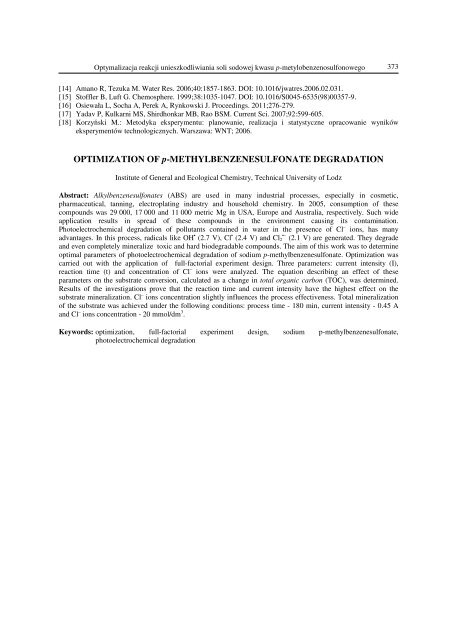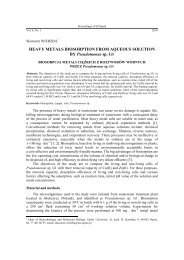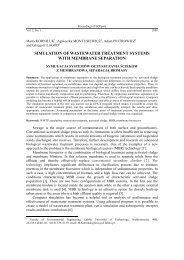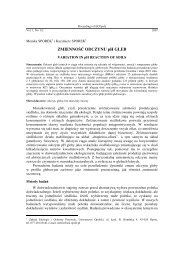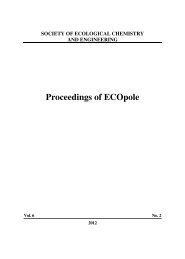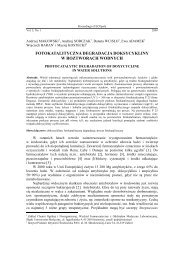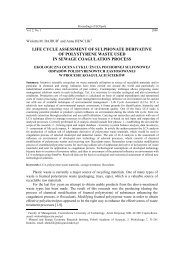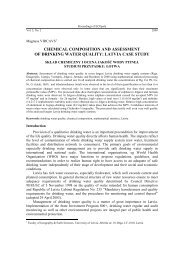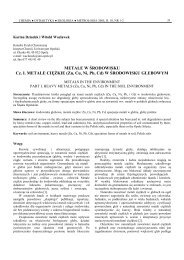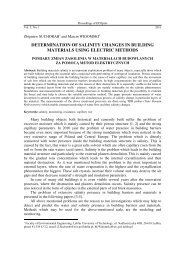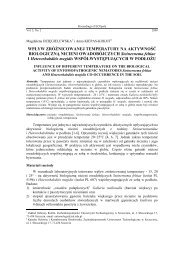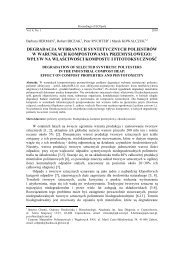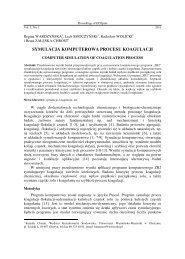Download part 3 of the issue - Uniwersytet Opolski
Download part 3 of the issue - Uniwersytet Opolski
Download part 3 of the issue - Uniwersytet Opolski
You also want an ePaper? Increase the reach of your titles
YUMPU automatically turns print PDFs into web optimized ePapers that Google loves.
Optymalizacja reakcji unieszkodliwiania soli sodowej kwasu p-metylobenzenosulfonowego<br />
[14] Amano R, Tezuka M. Water Res. 2006;40:1857-1863. DOI: 10.1016/jwatres.2006.02.031.<br />
[15] St<strong>of</strong>fler B, Luft G. Chemosphere. 1999;38:1035-1047. DOI: 10.1016/S0045-6535(98)00357-9.<br />
[16] Osiewała L, Socha A, Perek A, Rynkowski J. Proceedings. 2011;276-279.<br />
[17] Yadav P, Kulkarni MS, Shirdhonkar MB, Rao BSM. Current Sci. 2007;92:599-605.<br />
[18] Korzyński M.: Metodyka eksperymentu: planowanie, realizacja i statystyczne opracowanie wyników<br />
eksperymentów technologicznych. Warszawa: WNT; 2006.<br />
OPTIMIZATION OF p-METHYLBENZENESULFONATE DEGRADATION<br />
Institute <strong>of</strong> General and Ecological Chemistry, Technical University <strong>of</strong> Lodz<br />
Abstract: Alkylbenzenesulfonates (ABS) are used in many industrial processes, especially in cosmetic,<br />
pharmaceutical, tanning, electroplating industry and household chemistry. In 2005, consumption <strong>of</strong> <strong>the</strong>se<br />
compounds was 29 000, 17 000 and 11 000 metric Mg in USA, Europe and Australia, respectively. Such wide<br />
application results in spread <strong>of</strong> <strong>the</strong>se compounds in <strong>the</strong> environment causing its contamination.<br />
Photoelectrochemical degradation <strong>of</strong> pollutants contained in water in <strong>the</strong> presence <strong>of</strong> Cl – ions, has many<br />
advantages. In this process, radicals like OH • (2.7 V), Cl • (2.4 V) and Cl2 •– (2.1 V) are generated. They degrade<br />
and even completely mineralize toxic and hard biodegradable compounds. The aim <strong>of</strong> this work was to determine<br />
optimal parameters <strong>of</strong> photoelectrochemical degradation <strong>of</strong> sodium p-methylbenzenesulfonate. Optimization was<br />
carried out with <strong>the</strong> application <strong>of</strong> full-factorial experiment design. Three parameters: current intensity (I),<br />
reaction time (t) and concentration <strong>of</strong> Cl – ions were analyzed. The equation describing an effect <strong>of</strong> <strong>the</strong>se<br />
parameters on <strong>the</strong> substrate conversion, calculated as a change in total organic carbon (TOC), was determined.<br />
Results <strong>of</strong> <strong>the</strong> investigations prove that <strong>the</strong> reaction time and current intensity have <strong>the</strong> highest effect on <strong>the</strong><br />
substrate mineralization. Cl – ions concentration slightly influences <strong>the</strong> process effectiveness. Total mineralization<br />
<strong>of</strong> <strong>the</strong> substrate was achieved under <strong>the</strong> following conditions: process time - 180 min, current intensity - 0.45 A<br />
and Cl – ions concentration - 20 mmol/dm 3 .<br />
Keywords: optimization, full-factorial experiment design, sodium p-methylbenzenesulfonate,<br />
photoelectrochemical degradation<br />
373


